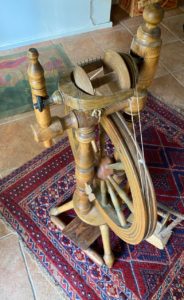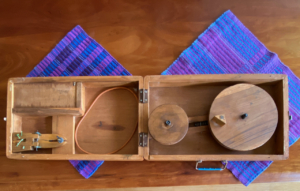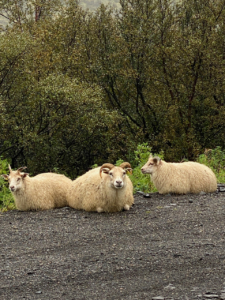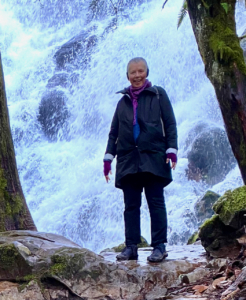As I trace my steps in the world of spinning, I realize it is not a straight progression. I think that’s okay because just as I have been told over and over again that there is no absolutely correct way to spin, I believe there is no absolutely correct way to learn how to spin. But the end is the same – the delicious accomplishment of turning fibres into yarn!
The childhood game of Snakes and Ladders provides a good image to describe my spinning steps. In the game gains and losses are made by rolling dice, moving along, and going up ladders or sliding down snakes depending on which square you land. This activity pretty accurately describes the emotionally affirming or bumpy fibre engagements that arose/arise during my ongoing spinning creativity. The four general fibre categories which I use with this game image are (in no particular order): dual coated, fine wools, medium wools, and “other” as they articulate my knowledge growth and ability to make yarn.
Other
My entrance into spinning wasn’t straightforward. I crept into it from several snakes and ladders sequences. My first attempt arose from knitting – a soothing occupation for me. I thought it would be fun to learn more about how knitting yarn was made. Further, my mom and dad had a still functional beautiful, old, upright flax spinning wheel with some Old Country (Ukrainian) handcarving on it, and I knew my dad had done some spinning as a boy in northern Manitoba. All this contributed to my first spinning ladder as I signed up for my initial spinning lesson in the 1970s. All the warm fuzzy feeling evaporated as I looked at the bugs crawling out of the fleece and the thick greasy knotty yarn the group of us spun. It was a long slide down the snake to its tail, an experience that convinced me I didn’t want to become a spinner.
I learned from this “other” experience, albeit quite a bit later, that if you don’t really know anything about a particular craft you want to try, it is a good idea to talk to people, do a little research, and make sure your instructors know how to teach.
Medium wools
I didn’t make another spinning attempt for 10 years, although I continued to knit and even started to weave. I got talked into trying spinning again by a fellow fibre enthusiast who had heard good things about the instructor. What a difference! There were no bugs, we used combed top, and the teacher knew how to teach. After the first evening I was utterly hooked. I bought myself an Ashford Joy on eBay and never looked back. During this explosive, exploratory time after my first course, I read as much as I could, watched videos from Interweave Press (now Long Thread Media), and tried out as many tools as possible. I became familiar with drum carders, wool hand carders, and built myself a niddy-noddy from plastic plumbing pipe with the help of my local building supply store. This period of spinning was a series of never-ending ladders with a few minor snake slips that just led me upwards to new ladders.
My “medium wool” period was a very satisfactory time as I consolidated my skills through hours of practice, taking workshops whenever I could, reading books, watching videos, and talking about the entire process with anyone vaguely interested in spinning in both the Greater Vancouver Weavers and Spinners Guild and the Richmond Weavers and Spinners Guild. I learned the fundamentals of spinning and saw how many more ladders there were to follow.
During this time I became aware of various sheep breeds and their fleece, but my go-to fleece at this point was the medium wool, Corriedale. In the late 1800s the breed was developed in New Zealand by crossing Merinos (fine wool, Spain) and Lincoln Longwools (heavy, long, lustrous wool, England) that resulted in sheep which could prosper in a dryer climate than Lincoln Longwools and a wetter climate than Merinos. I liked it, and continue to, as it has a good hand, texture, a pleasing feel, washes, knits, and weaves up well. Additionally, it was/is easy to get locally, reasonably priced, and easy/ier to control as a new spinner.
Other
The next dice role, based on a growing awareness and curiosity about other fibres brought me cotton and silk. The ladder rungs started with silk and then cotton. I started spindling silk while in Japan for a month. In my frenzied last-minute packing I added a top whorl spindle and some silk as it was small enough to fit into my luggage. I was staying near Nishijin, the silk textile area of Kyoto where many silk related ateliers exist, and with this backdrop I started spindling the silk I brought with me. I wasn’t good at spindling, but slowly, day after day of practice, I improved and began to enjoy the experience. I became used to fast spindle twirling to create thin silk strands and learned how to build a cop.
After some time I went to India with the first Maiwa Textile Tour (2006) and saw charkhas which I had also seen in Japan. After reading about Gandhi’s political stance of using the charkha to spin cotton cloth to free India from the economic impact of the British cloth trade, I had to use it. My first step towards spinning on a charkha was learning how to spin off the tip on a tahkli – a fast spinning, heavy, low-whorl spindle. It took a bit of time to achieve the 40–45 degree angle off the tip for creating a stable yarn from short fibred cotton. (Spinning from the tip for cotton also meant I could do this for all short fibres such as bison, yak, camel, and, in my dreams, cashmere!) Actual charkha spinning became a reality once I had mastered spinning off the tip on a supported spindle. The charkha requires spinning off the tip as one winds the wheel with the other hand. In addition to this skill, I managed to collect a book size and briefcase size charkha!
Reading and watching videos about different types of silks (muhga, bombyx mori, and tussah) and cottons (pima, Sea Island, and traditional coloured cotton), as well as the techniques necessary to spin an adequate yarn (spinning from the tip, using a tahkli, charkha, and spinning wheel) strengthened my understanding and capacity to produce the types of yarn that worked for my knitting and weaving projects. It also positioned me squarely in front of a new ladder: fine wools.
Fine wools
The Greater Vancouver Weavers and Spinners Guild proved to be the dice roll that brought me to my next ladder, fine wools. During a show and tell session I was handed a handspun piece of laceweight wool. I looked at it and immediately wanted to create a yarn like it so I could make myself a laceweight shawl.
My yarn for this rung was Blue Faced Leicester (BFL – yes, those puzzling three initials found in magazines). Colours for this breed run to mostly white with the occasional black or grey and when dyed take colour clearly. It is a lustrous, silky, fine long wool.
This fine wool experience backed by the cotton and silk spinning knowledge helped me integrate my mental and physical knowledge so spinning a consistent yarn was no longer a hit and miss endeavour. Examples of this include knowing to hold my hands farther apart for longer locks or how to cross-lace my bobbin for better pickup for laceweight wools. And now I have laceweight yarn just waiting to be knitted into a shawl…
Dual coated
For me, dual-coated fleece, of which Icelandic sheep are one example, represent a next ladder. And, as usual, I’m sure to find both snakes and ladders to challenge me. And, as an introduction, I will read such books as The Fleece and Fiber Sourcebook, check the internet for blogs, watch demonstrations, take online or face-to-face courses, and talk to anyone I can to help me master another skill. Although at the beginning of my spinning practice, I couldn’t hear any fleece yelling at me, let alone whispering a beguiling melody, I now can and look forward to hearing this sound for a long time.








Leave a Reply
Want to join the discussion?Feel free to contribute!